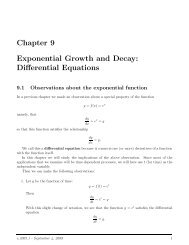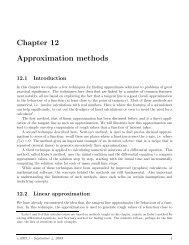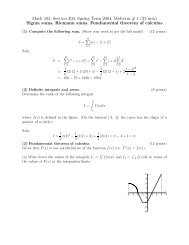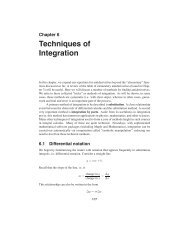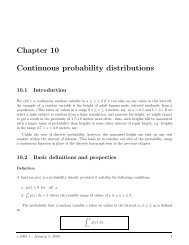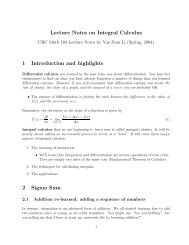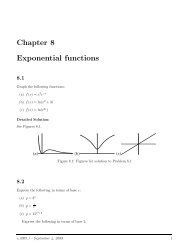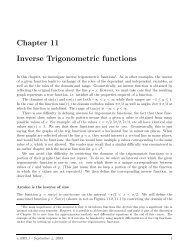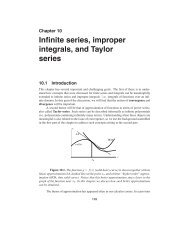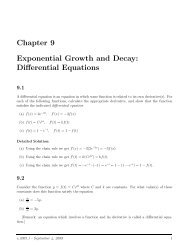Chapter 10 Trigonometric functions - Ugrad.math.ubc.ca
Chapter 10 Trigonometric functions - Ugrad.math.ubc.ca
Chapter 10 Trigonometric functions - Ugrad.math.ubc.ca
Create successful ePaper yourself
Turn your PDF publications into a flip-book with our unique Google optimized e-Paper software.
Math <strong>10</strong>2 Notes <strong>Chapter</strong> <strong>10</strong><br />
We differentiate both sides of this equation with respect to t, and obtain<br />
d tan(θ) dθ<br />
dθ dt = d ( ) s<br />
dt x(t)<br />
so that<br />
We <strong>ca</strong>n use the trigonometric identity<br />
sec 2 (θ) dθ<br />
dt = −s 1 dx<br />
x 2 dt<br />
dθ<br />
dt = −s 1<br />
sec 2 (θ)<br />
1 dx<br />
x 2 dt<br />
sec 2 (θ) = 1 + tan 2 (θ)<br />
to express our answer in terms only of the size, s, the distance of the object, x and the speed:<br />
so<br />
( s 2<br />
sec 2 x<br />
(θ) = 1 + =<br />
x) 2 + s 2<br />
dθ<br />
dt = −s x 2<br />
x 2 + s 2 1<br />
x 2 dx<br />
dt =<br />
x 2<br />
S<br />
x 2 + s 2v.<br />
(Two minus signs <strong>ca</strong>ncelled above.) Thus, the rate of change of the visual angle is sv/(x 2 + s 2 ).<br />
This <strong>ca</strong>lculation has some interesting impli<strong>ca</strong>tions for reactions to visual stimuli. We will explore<br />
some of these impli<strong>ca</strong>tions later on.<br />
<strong>10</strong>.9 <strong>Trigonometric</strong> <strong>functions</strong> and differential equations<br />
In this section, we will show the following relationship between trigonometric <strong>functions</strong> and differential<br />
equations:<br />
The <strong>functions</strong><br />
x(t) = cos(ωt), y(t) = sin(ωt)<br />
satisfy a pair of differential equations,<br />
dx<br />
dt = −ωy,<br />
dy<br />
dt = ωx.<br />
The <strong>functions</strong><br />
x(t) = cos(ωt),<br />
y(t) = sin(ωt)<br />
also satisfy a related differential equation with a second derivative<br />
d 2 x<br />
dt 2 = −ω2 x.<br />
To show that these statements are true, we return to an example explored in the previous section:<br />
we considered a point moving around a unit circle at a constant angular rate, ω, so that<br />
dθ<br />
dt = ω.<br />
v.2005.1 - September 4, 2009 20



